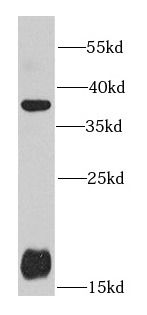Products
AMPK beta 1 antibody
Category:
Research Area:
- SPECIFICATIONS
- Product Name
- AMPK beta 1 antibody
- Catalogue No.
- FNab00377
- Size
- 100μg
- Form
- liquid
- Purification
- Immunogen affinity purified
- Purity
- ≥95% as determined by SDS-PAGE
- Clonality
- polyclonal
- Isotype
- IgG
- Storage
- PBS with 0.02% sodium azide and 50% glycerol pH 7.3, -20℃ for 12 months (Avoid repeated freeze / thaw cycles.)
Immunogen
- Immunogen
- protein kinase, AMP-activated, beta 1 non-catalytic subunit
- Alternative Names
- AMPK antibody, AMPK beta 1 antibody, AMPK subunit beta 1 antibody, AMPKb antibody, HAMPKb antibody, PRKAB1 antibody
- UniProt ID
- Q9Y478
- Observed MW
- 37 kDa
Application
- Tested Applications
- ELISA, WB, IHC
- Recommended dilution
- WB: 1:500 - 1:2000; IHC: 1:50 - 1:200
Validated Images
 mouse liver tissue were subjected to SDS PAGE followed by western blot with FNab00377( PRKAB1 Antibody) at dilution of 1:1000
mouse liver tissue were subjected to SDS PAGE followed by western blot with FNab00377( PRKAB1 Antibody) at dilution of 1:1000
 Immunohistochemistry of paraffin-embedded rat kidney using FNab00377(PRKAB1 antibody) at dilution of 1:100
Immunohistochemistry of paraffin-embedded rat kidney using FNab00377(PRKAB1 antibody) at dilution of 1:100
- Background
- The protein encoded by this gene is a regulatory subunit of the AMP-activated protein kinase (AMPK). AMPK is a heterotrimer consisting of an alpha catalytic subunit, and non-catalytic beta and gamma subunits. AMPK is an important energy-sensing enzyme that monitors cellular energy status. In response to cellular metabolic stresses, AMPK is activated, and thus phosphorylates and inactivates acetyl-CoA carboxylase (ACC) and beta-hydroxy beta-methylglutaryl-CoA reductase (HMGCR), key enzymes involved in regulating de novo biosynthesis of fatty acid and cholesterol. This subunit may be a positive regulator of AMPK activity. The myristoylation and phosphorylation of this subunit have been shown to affect the enzyme activity and cellular localization of AMPK. This subunit may also serve as an adaptor molecule mediating the association of the AMPK complex.



